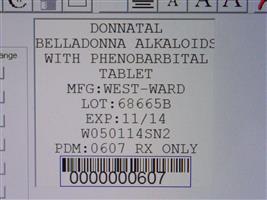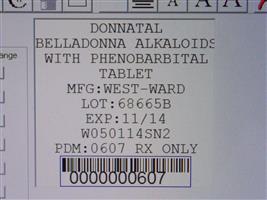Label: DONNATAL- phenobarbital, hyoscyamine sulfate, atropine sulfate, scopolamine hydrobromide tablet
-
Contains inactivated NDC Code(s)
NDC Code(s): 68151-0607-1 - Packager: Carilion Materials Management
- This is a repackaged label.
- Source NDC Code(s): 66213-425
- Category: HUMAN PRESCRIPTION DRUG LABEL
DISCLAIMER: This drug has not been found by FDA to be safe and effective, and this labeling has not been approved by FDA. For further information about unapproved drugs, click here.
Drug Label Information
Updated December 3, 2013
If you are a healthcare professional or from the pharmaceutical industry please visit this version.
- Download DRUG LABEL INFO: PDF XML
- Official Label (Printer Friendly)
-
Description
Each Donnatal® Tablet contains:
Phenobarbital, USP....................................... 16.2 mg
Hyoscyamine Sulfate, USP...................... 0.1037 mg
Atropine Sulfate, USP ...............................0.0194 mg
Scopolamine Hydrobromide, USP ...........0.0065 mg
INACTIVE INGREDIENTS: Anhydrous Lactose, Calcium Stearate, Colloidal
Silicon Dioxide, Corn Starch, and Microcrystalline Cellulose.
- INACTIVE INGREDIENTS
- CLINICAL PHARMACOLOGY
-
INDICATIONS AND USAGE
Based on a review of this drug by the National Academy of Sciences-National Research Council and/or other
information, FDA has classified the following indications as “possibly” effective:
For use as adjunctive therapy in the treatment of irritable bowel syndrome (irritable colon, spastic colon, mucous colitis)
and acute enterocolitis.
May also be useful as adjunctive therapy in the treatment of duodenal ulcer. IT HAS NOT BEEN SHOWN
CONCLUSIVELY WHETHER ANTICHOLINERGIC/ANTISPASMODIC DRUGS AID IN THE HEALING OF A
DUODENAL ULCER, DECREASE THE RATE OF RECURRENCES OR PREVENT COMPLICATIONS.
-
CONTRAINDICATIONS
Glaucoma, obstructive uropathy (for example, bladder neck obstruction due to prostatic hypertrophy); obstructive
disease of the gastrointestinal tract (as in achalasia, pyloroduodenal stenosis, etc.); paralytic ileus, intestinal atony of
the elderly or debilitated patient; unstable cardiovascular status in acute hemorrhage; severe ulcerative colitis
especially if complicated by toxic mega-colon; myasthenia gravis; hiatal hernia associated with reflux esophagitis.
Donnatal® is contraindicated in patients with known hypersensitivity to any of the ingredients. Phenobarbital is
contraindicated in acute intermittent porphyria and in those patients in whom phenobarbital produces restlessness
and/or excitement.
-
WARNINGS
In the presence of a high environmental temperature, heat prostration can occur with belladonna alkaloids (fever and
heatstroke due to decreased sweating).
Diarrhea may be an early symptom of incomplete intestinal obstruction, especially in patients with ileostomy or
colostomy. In this instance, treatment with this drug would be inappropriate and possibly harmful.
Donnatal® may produce drowsiness or blurred vision. The patient should be warned, should these occur, not to
engage in activities requiring mental alertness, such as operating a motor vehicle or other machinery, and not to
perform hazardous work.
Phenobarbital may decrease the effect of anticoagulants, and necessitate larger doses of the anticoagulant for optimal
effect. When the phenobarbital is discontinued, the dose of the anticoagulant may have to be decreased.
Phenobarbital may be habit forming and should not be administered to individuals known to be addiction prone or to
those with a history of physical and/or psychological dependence upon drugs.
Since barbiturates are metabolized in the liver, they should be used with caution and initial doses should be small in
patients with hepatic dysfunction.
-
PRECAUTIONS
Use with caution in patients with: autonomic neuropathy, hepatic or renal disease, hyperthyroidism, coronary heart
disease, congestive heart failure, cardiac arrhythmias, tachycardia, and hypertension.
Belladonna alkaloids may produce a delay in gastric emptying (antral stasis) which would complicate the management
of gastric ulcer.
Do not rely on the use of the drug in the presence of complication of biliary tract disease.
Theoretically, with overdosage, a curare-like action may occur.
- CARCINOGENESIS, MUTAGENESIS, IMPAIRMENT OF FERTILITY
- PREGNANCY
- NURSING MOTHERS
-
ADVERSE REACTIONS
Adverse reactions may include xerostomia; urinary hesitancy and retention; blurred vision; tachycardia; palpitation;
mydriasis; cycloplegia; increased ocular tension; loss of taste sense; headache; nervousness; drowsiness; weakness;
dizziness; insomnia; nausea; vomiting; impotence; suppression of lactation; constipation; bloated feeling;
musculoskeletal pain; severe allergic reaction or drug idiosyncrasies, including anaphylaxis, urticaria and other dermal
manifestations; and decreased sweating. Acquired hypersensitivity to barbituates consists chiefly in allergic reactions
that occur especially in persons who tend to have asthma, urticaria, angiodema and similar conditions. Hypersensitivity
reactions in this category include localized swelling, particularly of the eyelids, cheeks, or lips, and erythematous
dermatitis. Rarely, exfoliative dermatitis (e.g. Stevens-Johnson syndrome and toxic epidermal necrolysis) may be
caused by phenobarbital and can prove fatal. The skin eruption may be associated with fever, delirium, and marked
degenerative changes in the liver and other parenchymatous organs. In a few cases, megaloblastic anemia has been
associated with the chronic use of phenobarbital. Elderly patients may react with symptoms of excitement, agitation,
drowsiness, and other untoward manifestations to even small doses of the drug. Phenobarbital may produce
excitement in some patients, rather than a sedative effect. In patients habituated to barbiturates, abrupt withdrawal
may produce delirium or convulsions.
- DOSAGE AND ADMINISTRATION
-
OVERDOSAGE
The signs and symptoms of overdose are headache, nausea, vomiting, blurred vision, dilated pupils, hot and dry skin,
dizziness, dryness of the mouth, difficulty in swallowing, and CNS stimulation. Treatment should consist of gastric
lavage, emetics, and activated charcoal. If indicated, parenteral cholinergic agents such as physostigmine or
bethanechol chloride, should be used.
- How Supplied
- Belladonna Alkabids/Phenorbarb TAB
-
INGREDIENTS AND APPEARANCE
DONNATAL
phenobarbital, hyoscyamine sulfate, atropine sulfate, scopolamine hydrobromide tabletProduct Information Product Type HUMAN PRESCRIPTION DRUG Item Code (Source) NDC:68151-0607(NDC:66213-425) Route of Administration ORAL Active Ingredient/Active Moiety Ingredient Name Basis of Strength Strength PHENOBARBITAL (UNII: YQE403BP4D) (PHENOBARBITAL - UNII:YQE403BP4D) PHENOBARBITAL 16.2 mg HYOSCYAMINE SULFATE (UNII: F2R8V82B84) (HYOSCYAMINE - UNII:PX44XO846X) HYOSCYAMINE SULFATE 0.1037 mg ATROPINE SULFATE (UNII: 03J5ZE7KA5) (ATROPINE - UNII:7C0697DR9I) ATROPINE SULFATE 0.0194 mg SCOPOLAMINE HYDROBROMIDE (UNII: 451IFR0GXB) (SCOPOLAMINE - UNII:DL48G20X8X) SCOPOLAMINE HYDROBROMIDE 0.0065 mg Inactive Ingredients Ingredient Name Strength ANHYDROUS LACTOSE (UNII: 3SY5LH9PMK) CALCIUM STEARATE (UNII: 776XM7047L) SILICON DIOXIDE (UNII: ETJ7Z6XBU4) STARCH, CORN (UNII: O8232NY3SJ) CELLULOSE, MICROCRYSTALLINE (UNII: OP1R32D61U) Product Characteristics Color white Score no score Shape SEMI-CIRCLE Size 8mm Flavor Imprint Code D;Donnatal Contains Packaging # Item Code Package Description Marketing Start Date Marketing End Date 1 NDC:68151-0607-1 1 in 1 PACKAGE Marketing Information Marketing Category Application Number or Monograph Citation Marketing Start Date Marketing End Date unapproved drug other 05/07/2008 Labeler - Carilion Materials Management (079239644) Registrant - Carilion Materials Management (079239644) Establishment Name Address ID/FEI Business Operations Carilion Materials Management 079239644 REPACK(68151-0607)


